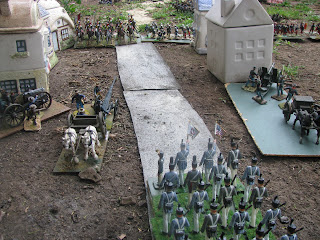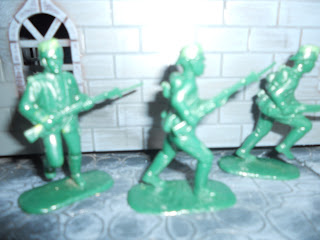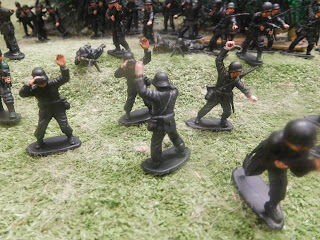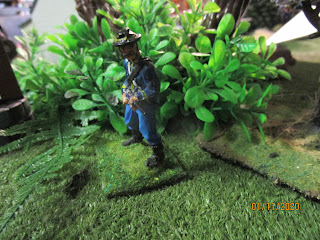Ameriga Invades Blueland - An Outdoor Wargame
I aim to have at least one wargame a year which is outside. Mat and I did the usual random army dice roll for a Victorian/Edwardian Funny Little Wars game. Mat ended up with Blusia (Army Horizon Blue) and I had army Red White and Blue (Ameriga).
Blusia has a province, an island called Blueland. It is known for its tourism, especially from Redia. (Many of the shop fronts have signs in Redian). Blusia has had a period of peaceful relations with Redia. Blueland is known for its blue flowers that often carpet the coastline. A supposed race of Blue Men also, allegedly, once inhabited the land. However, if they ever existed, they had long since been supplanted by Eskimos, who themselves had been colonized by Blusia. The population remained small, but the land had many resources and strategic significance.
Ameriga had long had military bases in Blueland and Amerigans had formed close ties with the Bluelanders and close ties with Blueland. Now Amerigan President Troommpevelt had insisted that Blueland become a province of Ameriga. This announcement had come out of the blue and was thought by President Pierre Marcel of Blusia, to be a joke.
However, in due course, during the Summer, army Red White and Blue arrived. A Blusian army had also arrived. Both armies converged on four villages.
Each army had six infantry regiments and two cavalry regiments, plus two artillery pieces and a gatling gun. The Blusian infantry were regulars and included two elite zouave regiments. The cavalry consisted of the elite cuirassiers and a lancer regiment. The artillery included a medium piece and a quick firing light horse artillery piece.
The Amerigans were mostly volunteers and untested in battle. The Rough Riders were an exception and known for their elite status. The artillery included the experimental dynamite gun and a medium field piece.
SETUP, RULES & VICTORY CONDITIONS
There was a winding road running the length of the battlefield and going between villages - four groups of buildings, loosely representing four villages. The larger central one was worth six points and the others five points each. For each enemy unit destroyed or routed at the end of the game another point would be awarded.
We used our adaptation of Paul Wright's Funny Little Wars. The differences included we allow a half move and fire with a dice penalty.
We used the FLW national army traits. For Blusia the rule is its army has to advance We modified that to say at least half the army had to advance each move. (We forgot about that for the first few moves but everything needed to advance to get to the objectives anyway). it also gets three shots from its light gun.
The gatling gets 12 dice but if three 1s are rolled it is jammed for the next move. Then there is a 50% chance of unjamming. if this occurs the gatling gets six shots that move. (My gatling jammed and was out of action one subsequent move).
We also had a rule that each cannon had six rounds of fire and then had to be re-supplied by wagons arriving from reserve. As it happened my wagons arrived very early, but I did not need the extra ammunition.
PROGESS OF THE GAME
Mat and I began from opposite ends of the front lawn. Thanks to trees and garden expanded to cater for tomato plants the yard was not that wide but hidden from prying eyes by a high metal fence.
The dice roll off for who would setup first was a tie. Usually, we would roll again but I suggested simultaneous set up to save time. Forces were so far from each other it did not make a big difference.
The next dice roll was for first move, which I won.
My troops formed a line across the battlefield, with the cavalry concentrated on the left. An artillery piece and West Point cadets marched in column on the road. The aim was to get there the quickest and with the 'mostest'. I managed to do just that but made the risky move of putting my artillery and gatling in advance of the rest of the army. We had tested our stand-in matchstick shooting piece which was a Lone Star desert gun. its range was not overly impressive; it was about half the length of the battlefield.
BELOW: The Blusian army deployed
At a later stage - face off in the center.Amerigan deployment at the start.
After sustaining significant casualties, the militia quality troops temporarily flee to the road. Mat maintained a strong center.
Amerigan troops at the start with West Point cadets about to go on the road.
The Amerigan commander is known for his casual attire.
View from the Blusian end of the field
Amerigan view of the battlefield
View from the Rough Riders as they threaten the Blusian flank.
At one point the Rough Riders dismounted and fired through a space between the buildings.
The Blusians had made a bold advance down the main street of Centertown. Lancers and Legionaries threaten the forwardly placed Amerigan gatling and artillery.
Westpointers move up in support of the artillery and gatling. The cannon fire was ineffective until the dynamite gun's round landed smack on the lancers' trumpeter, destroying the entire unit! However, the Legion's shooting would kill off most of the crew. The crew of the medium piece to the right was also mostly killed. The gatling crew survived and later moved position after the legion in front of them withdrew due to excessive casualties.
Blusian army. The church and windmill remained in Blusian possession.
Initial Blusian advance
Amerigan cavalry - the 7th cavalry, at left was charged by the Blusian cuirassiers and wiped out.
General Swiftwell and his standard bearer. In front of them is Colonel Boer's regiment and Colonel Blackdom's Colored regiment. The Westpointers are on the road.
Three villages can be seen here. At the end of the battle the Amerigans held the two at right and were still contesting Centertown at left.
At far left can just be seen the immense Statue of Innocence. In a later date this would be dismantled and sent to Ameriga for reassembly.
Blusians wearing two experimental uniforms. In the end the greenish one was abandoned. traditionalists preferred the blue and the greenish color was too close to the Hermans' new Field Gray.
The Amerigan units rolled for their troop quality status only when they began shooting. This revealed two elite infantry units. Three of the rest of the six infantry units were militia quality and so was the 7th cavalry (obviously not THE 7th Cavalry). This meant they had a minus one in shooting and other penalties such as a lower breaking point and less effective in combat. So, the Amerigan troops were, on average, somewhat outclassed by the Blusians.
The taller forests are made from repurposed Xmas trees.










































That looks very, very good!
ReplyDelete